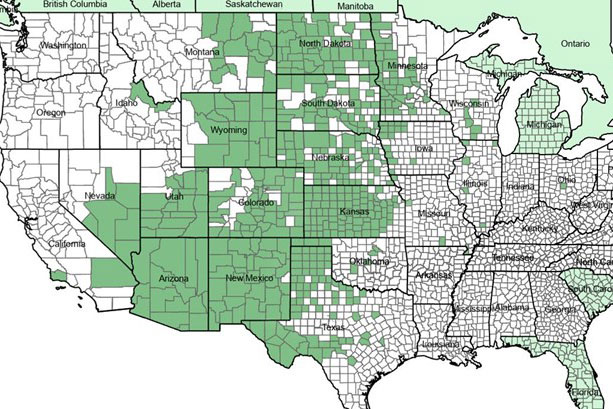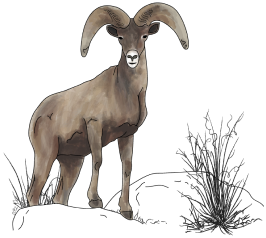Bouteloua gracilis (Kunth) Lag. ex Griffiths
Viridiplantae > Streptophyta > Streptophytina > Embryophyta > Tracheophyta > Euphyllophyta > Spermatophyta > Magnoliopsida > Mesangiospermae > Liliopsida > Petrosaviidae > Commelinids > Poales > Poaceae > PACMAD > Chloridoideae > Cynodonteae > Boutelouodinae > Boutelouinae > Bouteloua > Bouteloua gracilis [1]
![Habit of Bouteloua gracilis in clumping form [12].](/crfs/images/native-plants/plant-directory/bluegrama-first.jpg)
Habit of Bouteloua gracilis in clumping form [12].
Perennial, often with short, stout rhizomes, sometimes mat-forming. Culms tufted, 1-6(7) dm tall, erect or decumbent to geniculate-sprawling, glabrous or the nodes minutely hairy. Leaves basal. Sheaths glabrous or sparsely long-hairy, sometimes with tufts of hair lateral to the ligule. Blades 0.5-2.2 mm wide, flat to involute, often recurved, scaberulous to short-hairy. Ligule is a ring of hairs, sometimes membranous-based, the whole less than 1 mm long. Inflorescence a panicle of 1-3(4) persistent, ascending to spreading, spikelike branches, these 1-4.5(5) cm long, pectinate, the rachis generally arcuate, usually pubescent at the base and glabrous or scabrous above, terminating in one or more rudimentary spikelets. Spikelets densely crowded (30-90 per bunch), at maturity widely spreading, disarticulating above the glumes, subterete to strongly keeled, generally 4-6 mm long excluding the awns, each with 1 or 2 rudimentary florets above the perfect one. Glumes unequal, the first membranous and small, the second firm, lanceolate, 3.5-6 (6.5) mm long, slightly shorter than fertile lemma, long-tapered to a sharply acute tip, pale or purple-tinged, glabrous or the midnerve scabrous to pubescent with simple or papilla-based hairs. Lemma of the lower floret rounded or keeled on the back, 4-6.5 mm long, pubescent at least below and bearded on the callus, the mid-nerve prolonged between 2 slender lobes as an awn 1-3 mm long, the lateral nerves often prolonged as small bristles. Anthers mostly 2.5-3.5 mm long. First rudiment with a 3-lobed lemma surpassed by the long hairs at the summit of the rachilla and terminating in 3 awns 2.5-5 mm long. Second rudiment (when present) obovate, 1-2 mm long and awnless [2].
![Photos showing rachis apex in Bouteloua gracilis (top) and Bouteloua hirsuta (bottom) [13].](/crfs/images/native-plants/plant-directory/bluegrama-sec.jpg)
Photos showing rachis apex in Bouteloua gracilis (top) and Bouteloua hirsuta (bottom) [13].
Bouteloua gracilis (Blue Grama) can be distinguished from Bouteloua hirsuta (Hairy Grama) by its rachis which terminates in a rudimentary floret or spikelet whereas Bouteloua hirsuta has a sharp point extending 5-20 mm beyond the florets [2]. Bouteloua trifida (Red Grama) terminates in a well-developed spikelet and the body of the lemmas is up to around 2 mm long whereas Bouteloua gracilis’ lemma is 4-6.5 mm long [2]. The culms of Bouteloua eriopoda (Black Grama) are white-wooly, especially at lower internodes, whereas B. gracilis has culms that are glabrous and not at all wooly [2]. Bouteloua dactyloides (Buffalograss) is a somewhat similar but shorter species, being < 6 inches (15 cm) high and is typical of dry, short-grass plains [3].
Bouteloua gracilis is native from Manitoba to South America, where it grades from mat-forming in northern latitudes to clump-forming in southern latitudes. This morphological gradient has in part created a challenging taxonomic history, with a number of species recognized based on varying morphological characters [4].
![Dried stalks within clump of Bouteloua gracilis during winter months [15].](/crfs/images/native-plants/plant-directory/bluegrama-third.jpg)
Dried stalks within clump of Bouteloua gracilis during winter months [15].
Bouteloua gracilis is perhaps the most economically important species in the genus and considered one of the most important forage grasses in native ranges by contemporary ranchers and Native Americans alike [3]. Bouteloua gracilis is widely used for reseeding abandoned farmland and severely depleted pastures of the Great Plains [6] and is suitable for mixtures of grasses used in erosion control, low maintenance turf plantings, and surface mine revegetation [7].
Native American tribes including the Apache, Zuni, Navajo, and Hopi variously used the stems for brushes, brooms, and as inner fibers in basket-making [8]. Native Americans also ate the seeds raw or cooked as porridge, or ground into a powder and mixed with other meal to make bread [9]. The Navajo made a decoction of the whole plant to aid in postpartum distress [9].

[10]
Blue Grama (Bouteloua gracilis) has most recently been assessed for The IUCN Red List of Threatened Species in 2009. Bouteloua gracilis is listed as Least Concern [11]. However, in certain regions it is at risk of being extirpated [5].
This plant can be found in warm desert biomes, and is localized to salt desert shrub, desert shrub, grass-sagebrush, pinyon-juniper, and ponderosa pine communities between 980 and 2960 m in its native range [2].
[1] "Taxonomy Browser (Bouteloua Gracilis)." National Center for Biotechnology Information, www.ncbi.nlm.nih.gov/Taxonomy/Browser/wwwtax.cgi?mode=Info&id=48732.
[2] Welsh, S. L. 2003. A Utah flora. 3rd ed., Brigham Young University Press. ISBN 0-8425-2556-4
[3] "Bouteloua gracilis (Blue Grama): Native Plants of North America." Lady Bird Johnson Wildflower Center - The Botanic Garden of Texas, 8 July 2022, www.wildflower.org/plants/result.php?id_plant=bogr2.
[4] "Chondrosium gracile Kunth." Tropicos, Missouri Botanical Garden, tropicos.org/name/25518100.
[5] "Bouteloua gracilis Blue Grama." NatureServe Explorer 2.0, explorer.natureserve.org/Taxon/ELEMENT_GLOBAL.2.145624/Bouteloua_gracilis
[6] Riegel, Andrew. “Life History and Habits of Blue Grama.” Transactions of the Kansas Academy of Science (1903-), vol. 44, JSTOR, 3 Apr. 1941, p. 76. Crossref, doi:10.2307/3624869.
[7] USDA NRCS Plant Materials Program. "Blue Grama Bouteloua gracilis (Willd. ex Kunth.) Lag. ex Griffiths Plant Fact Sheet." USDA Plants Database, 1 Feb. 2002, plants.sc.egov.usda.gov/DocumentLibrary/factsheet/pdf/fs_bogr2.pdf.
[8] Native American Ethnobotany Database, http://naeb.brit.org/uses/search/?string=bouteloua accessed 23 nov 2022.
[9] Moerman, Daniel E. 1998. Native American Ethnobotany. Timber Press, Oregon.
[10] USDA NRCS National Plant Data Team. "Bouteloua gracilis (Willd. ex Kunth) Lag. ex Griffiths Plant Profile." USDA Plants Database, plants.usda.gov/home/plantProfile?symbol=BOGR2.
[11] "Bouteloua gracilis Red List Assessment." IUCN Red List of Threatened Species, www.iucnredlist.org/species/44392665/44423567.
[12] Dziuk, Peter M. "bouteloua-gracilis-01." Photograph. Minnesota Wildflowers, 2001, https://www.minnesotawildflowers.info/udata/r9ndp23q/pd3/bouteloua-gracilis-01.jpg.
[13] Dziuk, Peter M. "bouteloua-gracilis-hirsuta-compare-14-3." Photograph. Minnesota Wildflowers, 2014, www.minnesotawildflowers.info/udata/r9ndp23q/pd3/bouteloua-gracilis-hirsuta-compare-14-3.jpg.
[14] Dziuk, Peter M. "bouteloua-gracilis-14-1." Photograph. Minnesota Wildflowers, 2014, https://www.minnesotawildflowers.info/udata/r9ndp23q/pd3/bouteloua-gracilis-14-1.jpg.
[15] Dziuk, Peter M. "bouteloua-gracilis-1215-2." Photograph. Minnesota Wildflowers, 2015, https://www.minnesotawildflowers.info/udata/r9ndp23q/pd3/bouteloua-gracilis-1215-2.jpg



